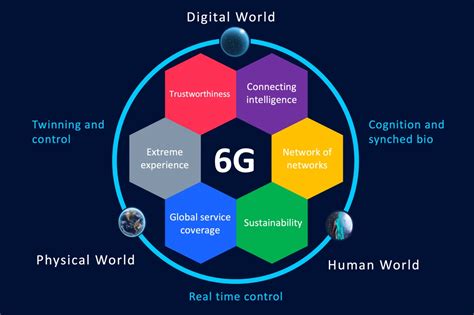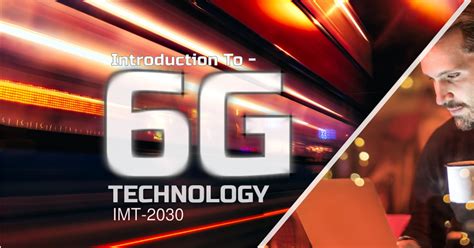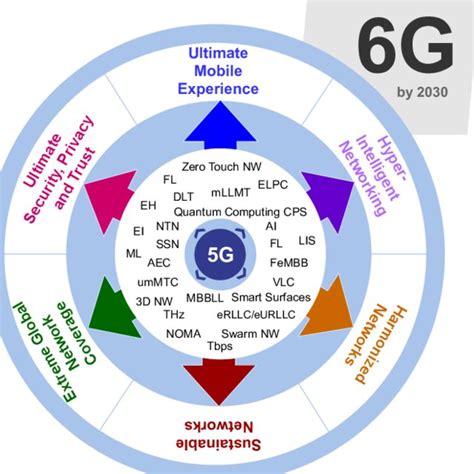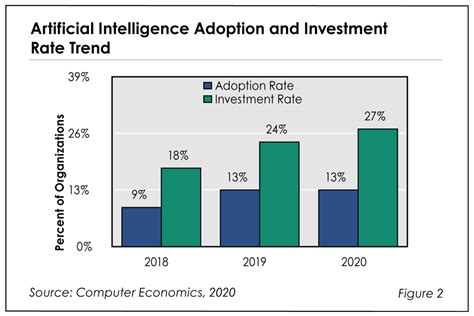Breaking News


Popular News


Learn about the evolution from 5G to 6G, global adoption, and emerging technologies in this comprehensive introduction to 6G technology blog post.In our rapidly advancing digital world, the evolution of communication technology never ceases. As we continue to witness the remarkable impact of 5G technology across various industries, the next generation of wireless communication, 6G, is already on the horizon. In this blog post, we will explore the roadmap to 6G, highlighting the key milestones and developments shaping its emergence.
We will begin by delving into the introduction of 6G technology, providing an overview of its potential capabilities and implications. From there, we will trace the evolution from 5G to 6G, understanding the technological advancements that will differentiate the two generations. Additionally, we will examine the ongoing research and innovation initiatives driving the development of 6G, as well as the emerging technologies that are expected to define its implementation. Finally, we will analyze the global adoption and market trends surrounding 6G, offering insights into its anticipated impact on the digital landscape. Join us on this journey as we unravel the future of wireless communication.
Contents

6G technology refers to the next generation of wireless communications, following on from the current 5G standard. It is expected to provide even faster internet speeds, lower latency, and greater capacity, revolutionizing the way we connect and communicate. With the potential to support advanced technologies such as holographic projections, seamless virtual reality, and ultra-precise telemedicine, 6G is set to bring about a new era of connectivity and innovation.
Building on the advancements of 5G, 6G technology aims to further enhance the user experience, enabling more efficient data transfer and enabling new applications across industries such as healthcare, transportation, and entertainment. With its focus on ultra-reliable, ultra-low-latency communication, 6G is poised to unlock the full potential of emerging technologies such as artificial intelligence, IoT, and advanced robotics.
As we strive towards the development of 6G technology, it is essential to understand the key concepts, principles, and potential use cases that will shape the future of connectivity. Stay tuned as we explore the evolution from 5G to 6G, emerging technologies in 6G, and the global adoption and market trends that are driving the roadmap to 6G.

Evolution from 5G to 6G
The evolution from 5G to 6G marks the next phase in the development of wireless communication technology. 5G technology has revolutionized the way we connect, communicate, and consume data, but as our digital world continues to expand, the need for even faster, more efficient, and more reliable networks becomes increasingly clear. With 6G, we are looking at the potential for data speeds that are 100 times faster than 5G, opening up a whole new realm of possibilities for industries and individuals alike.
One of the key developments in the transition from 5G to 6G is the growing focus on the use of terahertz frequencies. While 5G primarily operates within the sub-6GHz and millimeter-wave spectrum, 6G will likely leverage terahertz frequencies, which offer even greater bandwidth and data transfer rates. This shift will require significant advancements in hardware and infrastructure, as well as new approaches to network architecture and signal processing.
As we look ahead to the transition from 5G to 6G, it is important to consider not only the technical advancements but also the potential impact on society. The move to 6G will bring about new opportunities for innovation in areas such as artificial intelligence, augmented reality, and the Internet of Things. It will also raise important questions about privacy, security, and digital inclusion. By understanding the evolution from 5G to 6G and the milestones that will shape this transition, we can better prepare for the changes and opportunities that lie ahead.

The research and innovation initiatives in the field of 6G technology are crucial for the development and advancement of the next generation of wireless communication. As the world looks towards the future, there is a growing emphasis on the need for groundbreaking research and innovative projects that will shape the way we connect and communicate. These initiatives involve collaborations between academia, industry, and government entities, with a focus on exploring new possibilities and pushing the boundaries of technology.
One of the key initiatives in the realm of 6G is the establishment of research labs and centers dedicated to studying and experimenting with advanced wireless technologies. These facilities serve as hubs for pioneering research, experimentation, and testing of 6G concepts and prototypes. Leading academic institutions and technology companies are investing in these labs to drive innovation and foster collaboration among experts in the field.
Furthermore, collaborative research projects and consortia are playing a pivotal role in advancing the development of 6G technology. These initiatives bring together experts from diverse disciplines such as engineering, computer science, telecommunications, and more to explore novel ideas and solutions. Through these collaborations, researchers are aiming to address the technical challenges and opportunities presented by 6G, paving the way for revolutionary breakthroughs in wireless communication.

As we look ahead to the future of cellular communication, it’s clear that 6G technology will bring about a whole new era of connectivity. With the potential to revolutionize the way we live, work, and interact with the world around us, 6G is expected to usher in an unprecedented level of technological advancement. One of the most exciting aspects of this upcoming 6G revolution is the emergence of new technologies that will power the next generation of wireless communication.
One of the key technologies that will be central to the development of 6G is terahertz communication. Terahertz waves have the potential to enable incredibly high data transfer rates, far surpassing the capabilities of current 5G technology. This will open up a whole new realm of possibilities for applications such as virtual and augmented reality, as well as high-definition video streaming and real-time gaming.
Another emerging technology that is set to play a crucial role in 6G is AI-driven communication networks. With artificial intelligence powering the optimization and management of network resources, 6G networks will be able to dynamically adapt to changing conditions and deliver a seamless, high-quality user experience. This will be essential in enabling the diverse range of use cases that are expected to be supported by 6G, from autonomous vehicles to remote surgery.

In recent years, the global adoption of new technologies has been a driving force in the development of the telecommunications industry. With the upcoming shift to 6G technology, market trends are expected to take a significant turn. Companies worldwide are ramping up their efforts to innovate and create products and services that will cater to the demands of the 6G market.
Research and development initiatives are crucial in forecasting market trends for the global adoption of 6G technology. As companies invest in emerging technologies, there is a growing need to ensure that these innovations align with market demands and consumer preferences. The shift towards 6G technology will require companies to adapt to new standards, and the market trends will reflect this transition.
Key developments in the global adoption of 6G technology can be categorized and analyzed through a systematic approach. The evolution from 5G to 6G will pave the way for advancements in various industries, and the market trends will illustrate the impact of these innovations on a global scale.
| Global Adoption and Market Trends | Description |
|---|---|
| Increased Connectivity | As 6G technology becomes more widespread, the global connectivity will see a significant improvement. This will lead to the development of new applications and services that rely on seamless connectivity. |
| Industry Integration | Various industries such as healthcare, manufacturing, and transportation will integrate 6G technology into their operations, leading to an increase in efficiency and productivity. |
| Consumer Behavior | Consumer adoption of 6G technology will drive market trends, influencing the development of innovative products and services tailored to meet the evolving needs of the market. |

What is 6G?
6G refers to the sixth generation of wireless technology, which is expected to succeed 5G in the future.
What are the key features of 6G?
Some key features of 6G may include faster data speeds, lower latency, improved energy efficiency, and advanced artificial intelligence integration.
What are the potential applications of 6G?
Potential applications of 6G may include augmented reality, virtual reality, autonomous vehicles, smart cities, and advanced industrial automation.
What are the expected milestones for 6G?
The exact timeline for 6G deployment is still uncertain, but some industry experts predict commercialization by the late 2020s to early 2030s.
What are the challenges in developing 6G technology?
Challenges in developing 6G technology may include spectrum allocation, infrastructure requirements, security concerns, and international collaboration.
How is 6G expected to impact the digital economy?
6G is expected to significantly impact the digital economy by enabling new innovations, enhancing productivity, and creating new business opportunities in various industries.
What are the current research and development efforts for 6G?
Several research organizations, academic institutions, and industry players are already conducting R&D efforts to explore and develop the potential technologies for 6G.